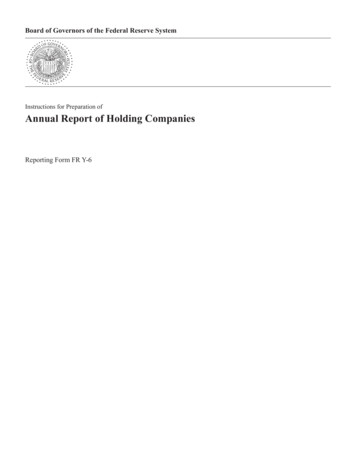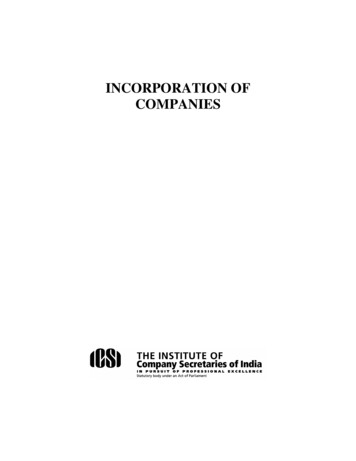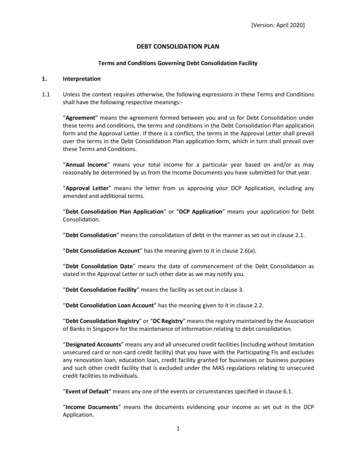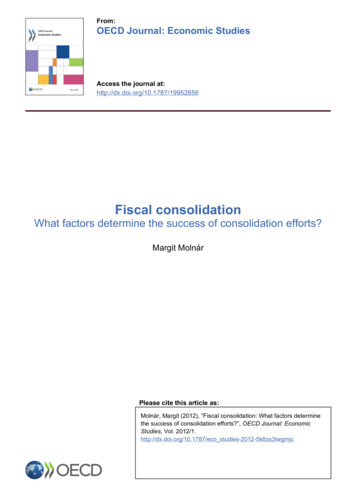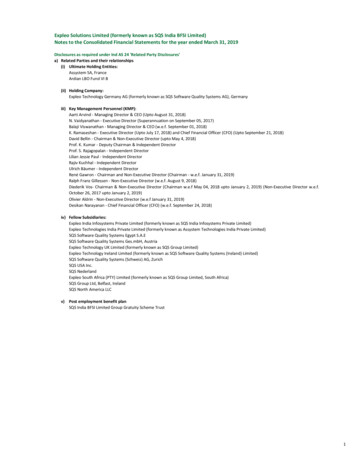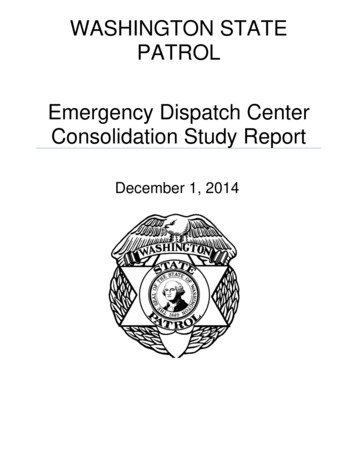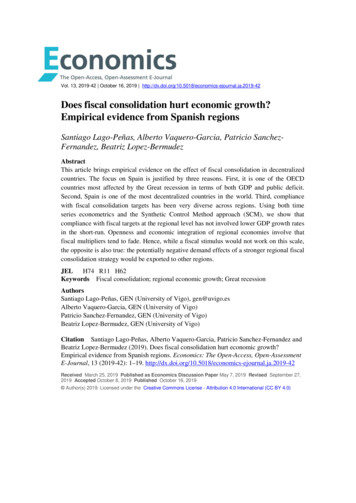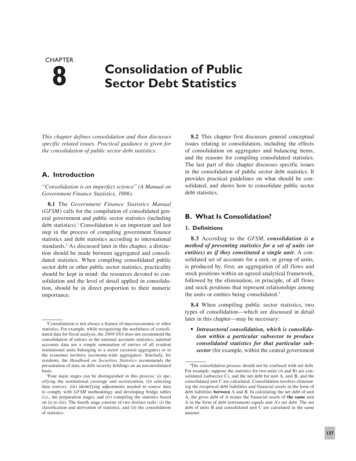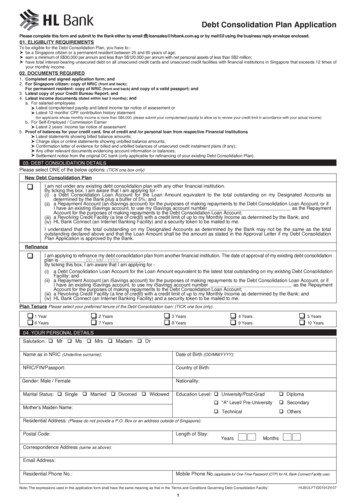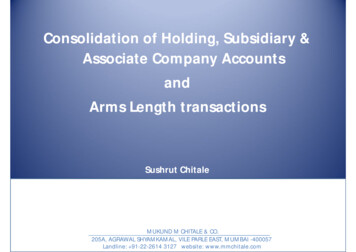
Transcription
Consolidation of Holding, Subsidiary &Associate Company AccountsandArms Length transactionsSushrut ChitaleMukund M Chitale & Co.MUKUND M CHITALE & CO.205A, AGRAWAL SHYAMKAMAL, VILE PARLE EAST, MUMBAI -400057Landline: 91-22-2614 3127 website: www.mmchitale.com
Consolidation of Holding, Subsidiary &Associate Company AccountsMukund M Chitale & Co.2
Why are we all here?Mukund M Chitale & Co.3
Interesting numbers Words commonly foundInstances in Cos Act 1956Instances in Cos Act 2013Prescribed209416Central Government685384Fraud2073Auditor145160Corporate Socialresponsibility014Private Company19026Key managerial personnel055Related party415Relative3210Thousand181122Lakh32191Mukund M Chitale & Co.4
Key definitions Financial statement – [sec 2 (40)] – definition already in force– Defined to include balance sheet,– profit & loss account / income & expenditure account,– cash flow statement,– statement of changes in equity,– explanatory notes, if applicable Financial statement for small / dormant company / OPC not toinclude cash flow statement Financial year – [ sec 2 (41)] – definition not in force– Defined as period ending on 31st March every year;– Where company is incorporated after 1st Jan in a year, financialyear will be till 31st March of the next year– Companies given 2 years to align financial year to April – MarchMukund M Chitale & Co.5
Key definitions– In case a company is a holding / subsidiary company of acompany incorporated outside India, and such company isrequired to consolidate its accounts outside India, a differentfinancial year can be followed subject to approval by the Tribunal Subsidiary company [Sec 2 (87)] means a company in which theholding company– Controls composition ( 50%) of the Board– Exercises or controls more than 50% of total share capital eitherby itself or together with one or more subsidiaries Limits to be prescribed on number of layers of subsidiaries Definition of subsidiary already in force except part pertaining tolayering of subsidiariesMukund M Chitale & Co.6
Key definitions Scenarios determining whether a company is a subsidiary or not:Total share capital of Z Ltd (Rs. Lakhs)Equity share capital100Preference share capital100Total share capital200 Scenario 1 : A Ltd holds 60% of equity share capital & 50% ofpreference share capital, with balance held by B Ltd Scenario 2 : A Ltd holds 51% of equity share capital. B Ltd holds 49%of equity capital and 100% of preference capitalMukund M Chitale & Co.7
Key definitions Associate company [Sec 2(6)] – definition already in force, in relationto another company,– means a company in which other company has significantinfluence (control of at least 20% of total share capital, or ofbusiness decisions under an agreement);– Includes a joint venture company– Does not include a subsidiary company Control [Sec 2(27)] - definition already in force, includes– Right to appoint majority of directors, or– Right to control management / policy decisions exercisable bypersons acting individually / in concert, directly / indirectly;including by virtue of shareholding / management rights /shareholders agreement / voting agreements / any othermannerMukund M Chitale & Co.8
Sec 129 – Financial statementNot in force Financial statements to be show true & fair view and need to be asper accounting standards. Board of Directors to lay before every annual general meeting thefinancial statements for the financial year. In case a company has any subsidiaries, associates or joint ventures,consolidated financial statements will also need to placed at theAGM.ScenarioImpact1) A Ltd holds 51% in BLtdCFS of A Ltd (including B Ltd) to bepresented2) A Ltd holds 51% in BLtd. B Ltd in turns holds100% in C LtdCFS of A ltd (including B Ltd and C Ltd) tobe presentedCFS of B Ltd (including C Ltd) also to bepresented)Mukund M Chitale & Co.9
Sec 129 – Financial statement (continued.) Company to disclose deviations, if any, from accounting standardsalong with reasons and financial effects thereof. Company to give key details of subsidiaries, associates and jointventures in a separate statement along with financial statements.Mukund M Chitale & Co.10
Sec 133 – Accounting standardsAlready in force CentralGovernment to prescribe accounting standardsrecommended by ICAI, in consultation with and after examination ofrecommendations made by NFRA. As per General Circular no. 15/2013, existing accounting standardsnotified under Companies Act 1956, shall continue to be applicable. Auditors report may have to partially changed to reflect the aboveMukund M Chitale & Co.11
AS 21 – Consolidated Financial Statements Objective – To formulate principles and procedures for preparationand presentation of consolidated financial statements. Scope – Applicable to Group of enterprises under the control of aparent; and investments in subsidiaries Cases excluded from application – amalgamations, investment inAssociates, investment in Joint Ventures Key definitions– Control – 50% of voting power; or Control of the composition of the Board, to obtain economicbenefits from its activities.– Subsidiary – an enterprise controlled by another enterprise– Parent – an enterprise that has one or more subsidiariesMukund M Chitale & Co.12
AS 21 – Consolidated Financial Statements– Equity – residual interest in assets of an enterprise afterdeducting all liabilities– Minority interest – part of net results of operations and of netassets of a subsidiary attributable to interests which are notowned directly / indirectly, by parent. Components of CFS – Consolidated balance sheet, consolidated profit& loss Account, notes and other explanatory material. Consolidatedcash flow statement to be prepared in case company preparesstandalone cash flow statement Consolidated financial statements to include all subsidiaries,domestic & foreign 1 Company can be a subsidiary of 2 holding companies at the sametime – in such cases, both parents to consolidate the same subsidiary.Mukund M Chitale & Co.13
AS 21 – Consolidated Financial Statements Cases where consolidation may not be required;– Control is intended to be for short-term & subsidiary is acquiredwith view to its subsequent disposal in the near future; or– It operates under severe long-term restrictions, whichsignificantly impair its ability to transfer funds to the parent.Consolidation procedures Financial statements of parent & subsidiaries to be combined on aline by line basis by adding like items of assets, liabilities, income &expenses Excess of cost to parent of its investment in each subsidiary over theparent’s portion of equity of each subsidiary, at the date ofinvestment, should be eliminated.– If cost of investment holding’s share in equity GOODWILL– If cost of investment holding’s share in equity CAPITALRESERVEMukund M Chitale & Co.14
AS 21 – Consolidated Financial Statements Net income pertaining to Minority shareholders to be deductedbefore arriving at net income attributable to parent. Minority interest in net assets to be shown separately from liability &equity pertaining to parent’s shareholders. Tax expense in CFS to be aggregate of tax expense in the separatefinancial statements of the parent and its subsidiaries. Where acquisition made in a step-by-step manner, consolidation tobe done from date when the parent actually acquires control of thesubsidiary Intra group balances and intra-group transactions and resultingunrealised profits should be eliminated in full. Unrealised lossesshould also be eliminated unless cost cannot be recovered.Mukund M Chitale & Co.15
AS 21 – Consolidated Financial Statements Financial statements used in consolidation to be drawn up to samereporting date. If reporting dates are different, adjustments foreffects of significant transactions/events between the 2 dates to bemade. Consolidation should be prepared using uniform accounting policies,unless it is not practicable to use the same. If accounting policiesfollowed are different, the fact should be disclosed together withproportion of such items. In the year in which parent subsidiary relationship ceases to exist,consolidation to be made up-to-date of cessation. Profit / loss on saleof investment in subsidiary to be separately disclosed.Mukund M Chitale & Co.16
AS 21 – Consolidated Financial StatementsDisclosures List of all subsidiaries giving name, country of incorporation orresidence, proportion of ownership and voting power the nature of relationship between parent and subsidiary, effect of the acquisition and disposal of subsidiaries on the financialposition, the results and corresponding amounts for the precedingperiod; and names of subsidiaries whose reporting dates are different than thatof the parent. when CFS are presented for the 1st time, figures for previous yearneed not be given. Other notes from separate financial statements which will assistreader in better understanding of CFS to be also included Additional disclosures mentioned in Schedule IIIMukund M Chitale & Co.17
AS 23 – Investment in Associates in CFS AS 23 – Accounting for Investment in Associates in ConsolidatedFinancial Statements Objective – set out principles & procedures for recognising effect ofinvestments in associates on financial position & operating results ofa group, in the CFS Scope – to be applied in case of accounting for investments inassociates in the preparation & presentation of CFS Key definitions –– Associate – an enterprise in which investor has significantinfluence & which is neither subsidiary nor joint venture– Significant influence – power to participate in financial and / oroperating policy decisions of investee but not control over thosepolicies (20% holding normally assumed as significant influence)– Control – definition same as in AS 21Mukund M Chitale & Co.18
AS 23 – Investment in Associates in CFSConsolidation procedures Investments in Associates to be recorded in CFS using equity method Investment to be initially recorded as cost, identifying goodwill /capital reserve arising at the time of acquisition. Carrying amount of investment is adjusted thereafter for the postacquisition change in investor’s share of net assets of the investee. Investor’s share of results of operations of investee to be included inConsolidated profit & loss account Goodwill/capital reserve arising on the acquisition of an associateincluded in the carrying amount of investment in the associate butshould be disclosed separately. Unrealised profits and losses resulting from transactions betweeninvestor (or its consolidated subsidiaries) and the associate should beeliminated to the extent of the investor’s interest in the associate.Mukund M Chitale & Co.19
AS 23 – Investment in Associates in CFS Unrealised losses should not be eliminated if & to the extent the costof the transferred asset cannot be recovered. Carrying amount of investment in an associate should be reduced torecognise a permanent decline in the value of investment. Suchrecognition should be determined and made for each and everyindividual investment. Equity method is not applied when investment is acquired & held forsubsequent disposal in near future; or there are severe long-termrestrictions that significantly impair associate’s ability to transferfunds to its investors. Investment in such associates should beaccounted for in accordance with the Accounting Standard (AS)-13,Accounting for Investments.Mukund M Chitale & Co.20
AS 23 – Investment in Associates in CFSDisclosures Investment in associates to be listed by proportion of ownershipinterest / voting power held in each associate Investments to be classified as long-term investments Investor's share of the profits / losses to be disclosed separately Associates where reporting date is different with difference in dates In case of difference in accounting policies between parent andassociate, make appropriate adjustments in CFS to account for thedifference. Where this is not practicable, the fact should be disclosedalong with a brief description of differences in accounting policies. Investor’s share of the contingencies and capital commitments of anassociate for which it is also contingently liableMukund M Chitale & Co.21
AS 27 – Consolidation of Joint Ventures Objective: The objective of this Standard is to set out principles andprocedure for accounting for interest in joint ventures and reportingof joint venture assets income , liabilities and expenses in thefinancial statement s of venturers and investors. Scope: This Standard should be applied for accounting for interests injoint ventures and the reporting of joint venture assets, liabilities,income and expenses in the financial statements of venturers andinvestors, regardless of the structures or forms under which the jointventure activities take place.Definitions: A joint venture is a contractual arrangement whereby two or moreparties undertake an economic activity, which is subject to jointcontrol. Joint control is the contractually agreed sharing of control over aneconomic activityMukund M Chitale & Co.22
Objective, Scope and Key DefinitionsDefinitions: Control is the power to govern the financial and operating policies ofan economic activity so as to obtain benefits from it. A venturer is a party to a joint venture and has joint control over thatjoint venture. An investor in a joint venture is a party to a joint venture and doesnot have joint control over that joint venture. Proportionate consolidation is a method of accounting and reportingwhereby a venturer's share of each of the assets, liabilities, incomeand expenses of a jointly controlled entity is reported as separate lineitems in the venturer's financial statements.Mukund M Chitale & Co.23
Recognition and Measurement Types of Joint VenturesJoint VentureJointly ControlledAssets (JCA)No entityincorporatedMukund M Chitale & Co.Jointly ControlledOperations (JCO)No entityincorporatedJointly ControlledEntities (JCE)New entityincorporated24
Recognition and MeasurementJointly Controlled Operations – Accounting Treatment Interests in jointly controlled Assets should be recognised by aventurer in its separate financial statements and consequently in itsconsolidated financial statements as below:– The assets that it controls and the liabilities that it incurs; and–The expenses that it incurs and its share of the income that itearns from the joint venture.Jointly Controlled Assets – Accounting Treatment Interests in jointly controlled Assets should be recognised by aventurer in its separate financial statements and consequently in itsconsolidated financial statements as below:– Its share of the jointly controlled assets, classified according tothe nature of the assets;– Any liabilities which it has incurred;Mukund M Chitale & Co.25
Recognition and Measurement.continued Jointly Controlled Assets – Accounting Treatment– Its share of any liabilities incurred jointly with the otherventurers in relation to the joint venture;– Any income from the sale or use of its share of the output of thejoint venture, together with its share of any expenses incurred bythe joint venture; and– Any expenses which it has incurred in respect of its interest inthe joint venture.Mukund M Chitale & Co.26
Recognition and Measurement continuedJointly Controlled Entities – Accounting Treatment A) In Separate Financial Statement of the Venturer:– interest should be accounted for as an investment in accordancewith Accounting Standard 13, Accounting for Investments B) In Consolidated financial statements of a venturer– interest is accounted for using proportionate consolidationexcept where an interest is acquired and held exclusively with a view to itssubsequent disposal in the near future; and an interest in a jointly controlled entity which operates undersevere long-term restrictions that significantly impair its abilityto transfer funds to the venturer.– Interest in such exceptions as mentioned above should beaccounted for as an investment in accordance with AccountingStandard 13, Accounting for Investments.Mukund M Chitale & Co.27
Recognition and Measurement continuedDiscontinuance of Joint Control A venturer should discontinue the use of proportionate consolidationfrom the date that:– It ceases to have joint control over a jointly controlled entity butretains, either in whole or in part, its interest in the entity; or– Where the jointly controlled entity operates under severe longterm restrictions that significantly impair its ability to transferfunds to the venturer.Mukund M Chitale & Co.28
Recognition and Measurement continuedAccounting treatment after discontinuance of Joint Control From the date of discontinuing the use of the proportionateconsolidation, interest in a jointly controlled entity should beaccounted for:– In accordance with Accounting Standard 21, ConsolidatedFinancial Statements, if the venturer acquires unilateral controlover the entity and becomes parent;– In all other cases, as an investment in accordance withAccounting Standard 13, Accounting for Investments, or inaccordance with Accounting Standard 23, Accounting forInvestments in Associates in Consolidated Financial Statements,as appropriate and,Mukund M Chitale & Co.29
Recognition and Measurement continuedTransaction between Venturer and Joint Venture If a venturer contributes or sells assets to a joint venture, and hastransferred significant risks and rewards of ownership, the venturershould recognise only that portion of the gain or loss which isattributable to the interests of the other venturers and should recognisethe full amount of any loss when the contribution or sale providesevidence of a reduction in the net realisable value of current assets oran impairment loss. If a venturer purchases assets from a joint venture, it should notrecognise its share of the profits of the joint venture from thetransaction until it resells the assets to an independent party. It shouldrecognise its share of losses resulting from these transactions when theyrepresent a reduction in the net realisable value of current assets or animpairment loss. In case of separate financial statements of the venturer, the full amountof gain or loss on the transactions is recognised. In case of consolidated financial statements, the venturer recognisesonly that share of the unrealised gain or loss which pertains to theinterests of other venturers.Mukund M Chitale & Co.30
Disclosure A venturer should disclose the following information in its separatefinancial statements as well as in consolidated financial statements: Aggregate amount of contingent liabilities, unless probability of lossis remote, separately from the amount of other contingent liabilities: Any contingent liabilities that the venturer has incurred in relation toits interests in joint ventures and its share in each of the contingentliabilities which have been incurred jointly with other venturers; Its share of the contingent liabilities of the joint ventures themselvesfor which it is contingently liable; and Those contingent liabilities that arise because the venturer iscontingently liable for the liabilities of the other venturers of a jointventure. A venturer should disclose the aggregate amount of the followingcommitments in respect of its interests in joint ventures separatelyfrom other commitments:Mukund M Chitale & Co.31
Disclosure continued‾‾‾‾Any capital commitments of the venturer in relation to itsinterests in joint ventures and its share in the capitalcommitments that have been incurred jointly with otherventurers; andIts share of the capital commitments of the joint venturesthemselves.A list of all joint ventures and description of interests insignificant joint ventures. In respect of jointly controlledentities, the venturer should also disclose the proportion ofownership interest, name and country of incorporation orresidence.In its separate financial statements, the aggregate amountsof each of the assets, liabilities, income and expenses relatedto its interests in the jointly controlled entities.Mukund M Chitale & Co.32
Arms length transactionsMukund M Chitale & Co.33
Sec 2 (76) - Related partyAlready in forceRelated party with reference to a companyA personDirector*KMP*FirmOr relativeis partnerControls actionAssociate coPvt CoIs member/ DirectorSubsidiaryPublic CoIs Director /holds withrelatives 2%paid up sh capBody corpControls actionof Board / MD/ ManagerHolding coSubsidiarySenior mgmt team (1 level belowED, incl Functional Heads) * - includes “relatives” KMP–CEO/MD/Manager, CS, WTD, CFOMukund M Chitale & Co.Director* / KMP* Manager – manages affairs of company(may / not be Director) Assoc Company - 20% of cap , JV34
Sec 2 (77) – Definition of relativeFather’s fatherMother’s fatherFather’s motherMother’s motherFatherBrotherAlready in forceMotherMr. AMrs. ASisterSon’s sonSonSon’s daughterSon’s wifeDaughterDaughter’s husband Relatives include all members of HUF Father, mother, son, daughter, brother, sister also includes steprelationsMukund M Chitale & Co.35
Sec 188 – Related party transactionsNot in force Following transactions entered in to with related parties are calledrelated party transactions;a) sale / purchase / supply of goods / materialsb) Selling / buying of propertyc) Leasing of propertyd) Availing / rendering of servicese) Appointment of agent for purchase / sale of goods / materials /services / propertyf) Related party’s appointment to office / place of profit in company/ subsidiary / associate companyg) Underwriting subscription of securities / derivatives of company “Office or place of profit” – any facility or remuneration received bythe related party. In case of director, any facility or remunerationreceived above what he is entitled as directorMukund M Chitale & Co.36
Sec 188 – Related party transactions. Not in forceApproval process forrelated party transactionsIs it an arm’s length transactionin ordinary course of businessYesOnly Boardresolution reqdNoIs paid up capital 1 croresNoYes1.Is value of total transactions in a) to e) aboveduring FY 5% of turnover, or 20% of NW asper last FY2.Is it about appointment to place of profit inco / sub / assoc for 1 lakhs p.m.3.Is underwriting contract for 10 lakhsYesTransactionsrequire priorapproval atAGM throughspecialresolutionNo All related party transactions (RPT) to be pre-approved / ratified byBoard / AGM within 3 months. Interested Director not to participate Interested member not to vote in AGM, for deciding approvalMukund M Chitale & Co.37
Sec 188 – Related party transactions. Not in force In case of 100% subsidiary, special resolution passed by holdingcompany is enough for transactions between holding company &subsidiary “Arms length transaction” – transaction between 2 related partiesthat is conducted as if they were unrelated, so that there is noconflict of interest Details of RPT to be mentioned in Board report, along withjustification for entering in to the same If Board / AGM does not ratify a RPT, contract voidable at company’soption. If contract is with related party of director, the concerneddirector to indemnify for any loss caused to company Register of related party transactions to be maintained if value percontract during financial year exceeds Rs. 5 lakhsMukund M Chitale & Co.38
ALP vs ALT Definition of Arm’s length transaction – sec 188 of Companies Act2013 - “Arms length transaction” – transaction between 2 relatedparties that is conducted as if they were unrelated, so that there is noconflict of interest Definition of Arm’s length price – Sec 92F of Income Tax Act, 1961 –“arm’s length price” means a price which is applied or proposed to beapplied in a transaction between persons other than associatedenterprises, in uncontrolled conditions. Companies Act considers arms length transaction and not arm’slength price – this should include other terms and conditions inaddition to price like credit terms, contingencies, other factors, etc. Definitions of related party different in Companies Act, transferpricing regulations, and AS 18 – relevant regulations to be consideredand applied accordingly Guidance from methods prescribed in TP regulations may be takenMukund M Chitale & Co.39
Methods to calculate Arm’s length price Methods to calculate arm’s length price “ALP” (as per Transfer PricingRules)– Comparable Uncontrolled Price Method (CUP method)– Resale Price Method (RPM)– Cost Plus Method (CPM)– Profit Split Method (PSM)– Transactional Net Margin Method (TNMM)– Other Method (OM) as prescribed by Board ‘Most appropriate method’ of the above to used to calculate ALPMukund M Chitale & Co.40
Factors determining appropriate method Following factor determine the most appropriate method to be usedto calculate ALP;– Nature & class of transactions– Types of related parties and their profile who enter in to suchtransactions– Availability, coverage and reliability of data pertaining toproposed / past transactions– Degree of comparability– Extent to which reliable & accurate adjustments can be made toaccount for difference in transactions In reality, most appropriate method is determined by availability ofcomparable data than any other factor. Most appropriate method to be with respect to each transaction typeand not with respect to each related partyMukund M Chitale & Co.41
Criteria for comparability of transactions Following criteria are relevant for determining comparability oftransactions (which assist in arriving at arm’s length price);– Quality of product / service– Quantity / value of transactions– Presence of intangibles (brand name / trademark)– Other material / physical features Example given in New Zealand Transfer Pricing Guidelines (quoted inGuidance note on report under section 92E of IT Act issued by ICAI);– Alkaline battery would sell at premium to standard battery– Branded battery will sell at premium to unbranded battery– Battery with additional features / packaging will attract premiumMukund M Chitale & Co.42
Criteria for comparability of transactions Contractual terms of transactions that determine comparability;– Terms of delivery (CIF, C&F, FOB)– Terms of payment– Discounts / credit period offered– Warranty– Installation services Generally, internal comparables are preferred over externalcomparables since transactions entered in to with related partiesprovide more reliable and accurate data. Data (with necessaryadjustments) between 2 unknown parties may not be available.Mukund M Chitale & Co.43
Comparable Uncontrolled Price (CUP) Method Most popular methodSale of company’sproducts torelated partySale of company’sproducts tooutsidersCalculation of comparable uncontrolledprice (ALP)A Ltd sells itsproducts torelated party @Rs. 2000 p.u. withfollowing terms;Price – FOBQuantity discount– YesCredit – 1 monthWarranty – NowarrantyA Ltd also sellssame product tooutsiders @ 3000p.u. with terms;Price – CIFQuantity discount –NoCredit – Cash &CarryWarranty – 6months warrantyPrice charged to outsiders3000(-) Cost of freight & insurance(550)(-) Value of quantity discount(20)( ) Value of credit per month(@ 12% p.a.)(30)Mukund M Chitale & Co.(-) cost of warranty for 6months based on technicalfactors & past experience(250)Comparable price (ALP)221044
Resale Price (RPM) Method Typically used where goods / services purchased and resold withoutany major value addition. More so, where goods purchased fromrelated parties are resold to unrelated parties. Method arrives at arm’s length purchase priceRelated partytransactionTransaction atarm’s lengthCalculation as per RPMA Ltd purchases100 units fromrelated party @2900 p.u. These areresold to B Ltd at3000 p.u. Otherterms are;Price – Ex shopQty disc–1 % of GPFreight inwards –Rs. 10A Ltd purchasessimilar productsfrom unrelatedsupplier & resellsto unrelated buyer@ 15% GP. Otherterms are;Price – CIFQty discount – NILFreight inwards –NILActual G P margin15%(-) Diff between ex shop & CIF(2%)(-) Diff due to qty discount(1%)Normal G P margin12%Mukund M Chitale & Co.Price charged to A Ltd3000(-) Normal GP margin @ 12%(360)(-) Freight inwards (ignored sincenot considered in actual GP)Comparable purchase price (ALP)(0)264045
Cost Plus (CPM) Method Typically used in case of transactions involving provision of services,transfer of semi-finished goods, and joint facility arrangements Method to be used only in case of supply / sale of goods / services.This method not to be used in case of receipt of goods / services.Related partytransactionTransaction atarm’s lengthCalculation as per RPMA Ltd developssoftware at cost ofRs. 175,000 andsells to relatedparty at Rs.200,000. Otherterms are;Tech supportcharges – YesDiscount – Rs. 8750Credit – Rs. 5250A Ltd providedsimilar services tounrelated partyand earned GP of50% on costs.Other terms are;Tech supportcharges – No.Value Rs. 17500Discount – NoCredit - NoG P margin for unrelated partyMukund M Chitale & Co.(-) Tech support (% of cost)(-) Discount (% of cost)50%(10%)(5%)( ) Credit (% of cost)2%Normal G P margin27%Costs incurred for sale torelated party175.000GP margin mark up @ 27%47,250Comparable sale price (ALP)222,25046
Profit Split (PSM) Method Used where activities performed by related parties are sointerrelated that it is not possible to segregate the same; or in casewhere 2 related parties use respective intangibles to develop aproduct and earn income through such saleTransaction with related partiesCalculation as per PSMA Ltd along with a related party in US jointly providesinvestment banking services to a client M Ltd in US &has following financials;Total price chargedto M Ltd50,000A Ltd share30,000Related party share20,000Total profits22,000A Ltd return – 70%15,400Co
Mukund M Chitale & Co. Key definitions Scenarios determining whether a company is a subsidiary or not: Scenario 1 : A Ltd holds 60% of equity share capital & 50% of preference share capital, with balance held by B Ltd Scenario 2 : A Ltd holds 51% of equity share capital. B Ltd holds 49% of equity capital and 100% of preference capital
